
14 minute read
University Scientists Grow Water Savings with Drought-tolerant Turfgrass
by TPIturfnews
UNIVERSITY SCIENTISTS GROW WATER SAVINGS
WITH DROUGHT-TOLERANT TURFGRASS
By Jennifer Howard
Editor’s note: When this article was written, on April 27, 2020, Covid-19 restrictions had dramatically impacted research activities. See the Sidebar for an update on how 2020 played out and what is predicted for research activities in 2021.
Which half of landscape water use is wasted? Experts estimate that more than 50 percent of our outdoor irrigation goes to waste—even more in dry years and dry climates. Our landscape watering habits are the primary culprit in this overflow. It’s a big issue. The typical suburban homeowner irrigates an estimated 10,000 gallons of water each year, primarily aimed at their lawn. Conserving our freshwater supply is essential for long term sustainability.
Saving Water & Natural Grass’ Benefits
Turfgrasses occupy over 30 million acres in the U.S. It’s tempting to assume that eliminating our outdoor grass carpeting could solve the water demand problem. But it’s not so simple. Natural grass provides substantial environmental and economic benefits in our landscape. It mitigates heat around our homes, stabilizes soil against erosion, provides safe play space, and reduces noise, glare, and pollution. Eliminating natural grass would create a whole new set of environmental challenges.
A network of turfgrass researchers from six major universities, including NC State, is solving this dilemma by developing turfgrasses that are attractive and healthy with minimal water.
NC State Leads New Research
The National Institute of Food and Agriculture approved a specialty crops grant to continue the multi-university
Milla-Lewis’s team reviews test plots in 2019.
group’s work producing drought-tolerant warm-season turfgrasses. The team (representing five universities— North Carolina State University, Texas A&M University, University of Florida, University of Georgia, and Oklahoma State University) has collaborated for ten years with a rotating leadership structure. For the five-year grant that began in 2020, the team decided to expand the evaluations out west and invited the University of California Riverside, lead by Dr. Jim Baird, to join in the collaboration. Thus, the team is now 32 scientists strong. NC State’s Dr. Susana Milla-Lewis, associate professor of Turfgrass Breeding and Genetics, is at the helm in their new phase of study. “Our 2010 and 2015 projects were crucial in the development of drought-tolerant turfgrass cultivars. The levels of improvement of these grasses are promising and validate the need to promote adoption, continue cultivar research, and develop tools that facilitate the breeding process,” Milla-Lewis said.
Early Season Success
The team of turfgrass researchers’ work has focused on selecting and testing drought-tolerant cultivars of four of the most economically important warm-season turfgrass species in the southern U.S. By exchanging plant materials and data among university breeders, turf varieties are tested under many climatic conditions, and the results accumulate quickly.
“The collaboration among breeders across such different environments is priceless,” Milla-Lewis said. “It helps us select better lines with more performance stability because they have been tested against a wide range of weather conditions like drought and cold as well as an array of pests and diseases.”
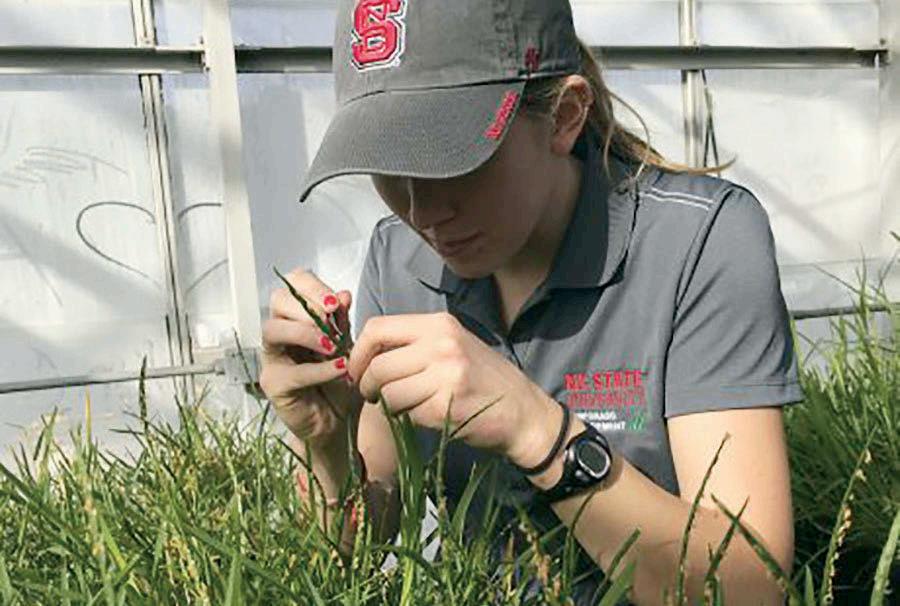
The team has already released six new drought-tolerant varieties from previous project phases including two bermudagrasses (‘TifTuf’ and ‘Tahoma 31’), two St. Augustine grasses (‘TamStar’ and ‘CitraBlue’), and two forthcoming zoysiagrass varieties.
With tangible success already, what will the next research phase include? More trials with new avenues to share and test them. Plant breeding is a long-range game, 10-15 years in most cases. The group has already evaluated over 2,500 potential varieties in their nine years together. Now Milla-Lewis and team are intent on warping this speed with new technology.
Tackling Turfgrass Technology
The group’s next phase of research will integrate tech specialists using drones and remote sensing devices to provide real-time feedback on plant stress—a plant breeder’s dream. But how does a robot sense plant stress?
Drones equipped with specialized sensors will be programmed to fly missions over the test plots to detect changes in turf color, ideally even before visible to the human eye. By measuring color change over time resulting from turf stress, researchers can rank the highest performers and concentrate on those showing the greatest genetic potential.
Technology also brings objectivity to plant breeding. Instead of researchers assigning a visual grade of 1-9 on turfgrass color, the drone sensors capture a binary “stress/no stress” assessment. It’s black or white—or brown or green in this case. Removing human bias will result in standardized scoring—important when measurements are taken across hundreds of plots at each of the collaborating universities. Because who’s to say someone’s turf score of a 6 in Raleigh is the same 6 as someone’s in Texas?
Using autonomous data collection, breeders can measure more traits, evaluate more trials—and even more varieties at a time. Increasing the volume of data generated in a short timeframe speeds the plant breeding process by weeding out low performing options. Researchers call it ‘high throughput phenotyping” and it promises to deliver fast feedback for a streamlined selection funnel. Greater testing volume into the research pipeline means better outcomes with the most resilient samples.
Consumer Education
Despite the team’s field research success, Milla-Lewis’s group recognized that improved varieties can’t deliver their inherent benefits if end users don’t adapt their lawn care. So the project’s phase III incorporates a significant extension and consumer outreach plan spearheaded by Jason Peake at the University of Georgia.
The nationwide campaign will include broadcast media, a consumer decision tool website, and printed marketing pieces all aimed at educating consumers on why they should choose a drought-tolerant grass and, importantly, how to properly manage it to reap all the benefits. After all, a new lawn doesn’t come with a care tag.

QUALITY SEED FOR SOD PRODUCTION
Gold Tag Certified Seed
Gold Tag certified seed is the highest standard for seed purity in the industry, however at Pennington Seed we go beyond the industry standard by requiring our seed be free of many more contaminants. We ensure that our seed is free of all crop and weed seed* when sold as Pennington® Gold Tag Seed. Our increased scrutiny ensures our customers are receiving the best sod quality seed available.
*Our Pennington® Gold Tag is verified as free of all crop and weed seeds in two independently drawn samples and submitted to two separate seed testing labs. While guaranteeing any lot of seed as being completely free of crop and weed seed is not possible, our testing procedures offer the highest verification offered.
Sod Resources
WATER STAR® QUALIFIED GRASS SEED
Pennington Seed has committed to the research and development of Water Star® Qualified grass seed.
CUSTOM SEED MIXES
Pennington has the experience necessary to blend a seed mixture that is suited specifically for your region.
NEXGEN TURF RESEARCH
Pennington is one of the only seed companies with its own research and development facility.
WWW.PENNINGTON.COM/PRO-TURF PROTURFSOLUTIONS@PENNINGTONSEED.COM
Industry Involvement
This new wave of consumer outreach will complement traditional extension activities such as field days and demonstration turf plots at public locations like municipal buildings (including NC State’s forthcoming N.C. Plant Science Initiative building). To see details on that project, check out this website. https://cals.ncsu.edu/psi/psb/
These opportunities will reach industry professionals like landscapers, contractors, and sod producers who are often the decision-makers in turfgrass variety selection. NC State turfgrass extension specialist Dr. Grady Miller says it’s not enough just to put new varieties out. “Like the old saying goes ‘Those near the cutting edge may get cut.’ Our efforts can convince the industry to adopt and produce, but the consumer needs to be able to properly manage the turfgrasses if we want these new varieties to be successful.”
“We’ve learned in our investigations that the average consumer is concerned about their grass’s environmental tolerance—to shade, drought, and winter-kill They are looking for low-maintenance landscapes,” Milla-Lewis noted.
Convincing homeowners to adopt these drought-tolerant grasses would deliver on both accounts. “We have a young consumer audience with very different landscape needs. For some, lawn maintenance is at best a hobby, and at worst a nuisance. They are looking for lawns requiring fewer inputs, even if it is more expensive,” concluded Miller.
New Conditions
Plant breeding didn’t end in the project’s phase II. It’s the heart of the project, but there’s always room to improve selections and methodology. “Some team members are working to understand what makes a grass more droughttolerant. Others use that information to identify which genes might be responsible for the improved performance. All this information can be used to quickly identify plant materials worth field testing, saving breeders time and resources,” Milla-Lewis said. The group is looking not only to refine the varieties but to quantify best management practice guidelines for the new turfgrass varieties. This will involve testing under multiple conditions: restricted rainfall, reclaimed water irrigation, salty-spray exposure, shade, sod strength for cutting, and other production aspects. Surviving these endurance tests will produce turfgrass uniquely adapted for low maintenance production and management.
Testing the Technology
Part of the team’s challenge isn’t just testing turfgrasses, but technology itself. Most UAV technology wasn’t developed for crop production. Part of the group’s forthcoming research will be devoted to figuring out the best ways to use technology in plant breeding and developing protocols to standardize use. Rob Austin is a GIS specialist at NC State, “We’re trying to figure out what works best for this application. Some experiments on drone use in plant breeding have been done, but largescale research is scarce.”
The group plans to collaborate on shared protocols that standardize drone data collection activities and data analysis techniques. Austin will oversee the Raleigh group’s data strategy. He sees opportunity in automating the workflow. “We don’t want to simply trade time in the field for time behind a computer screen,” Austin said, “We need standards and processes to translate the data into meaningful results.”
The Power of Teams
“The success of this project to date is because of teamwork. It just goes to show how much you can get done with a collaborative team—with no room for hierarchy,” Grady Miller noted. The multiuniversity team is guided by an industry advisory board providing feedback and input to direct the research for environmental and economic benefit.
Milla-Lewis’s leadership stint will extend the project for an additional four years. “The strength of this group resides not only in the wide range of expertise of the research and extension scientists involved in the project and how well we work together, but also in how closely we interact with our industry partners. They are our compass, making sure our deliverables fulfill real industry needs,” Milla-Lewis concluded.

The projected design of NC State’s North Carolina Plant Science Initiative This closeup view shows one of the turfgrass samples in the research program.
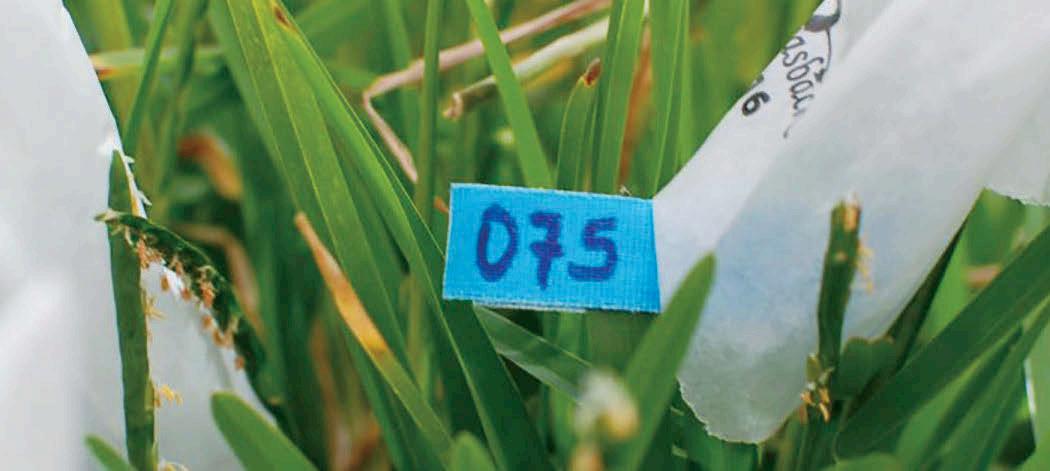
And Now By Susana Milla-Lewis
Covid-19 made the first year of our project a bit more interesting than expected! Safety measures and social distancing changed protocols and by mid-March most programs were in a lockdown. For breeders, propagation of materials and planting were delayed. For genomics teams, their labs were closed, and they were unable to generate new data. For the extension and outreach teams, cancellation of field days limited traditional summer educational activities. By fall, research operations were resumed with restrictions in place. Some states/ universities were more restrictive than others based on trending Covid-19 case numbers. Despite these setbacks, we were able to attain the main project goals for year one. This can be attributed to good communication among team members, creativity to come up with contingency plans, and ultimately the team’s commitment to this project which we all believe will have a significant impact on the turfgrass industry.
As vaccination progresses in the next few months, we expect restrictions to be slowly lifted. This should allow us to have a more normal field season this year and hopefully to regain capacity for holding face-to-face extension meetings in the not-too-distant future.
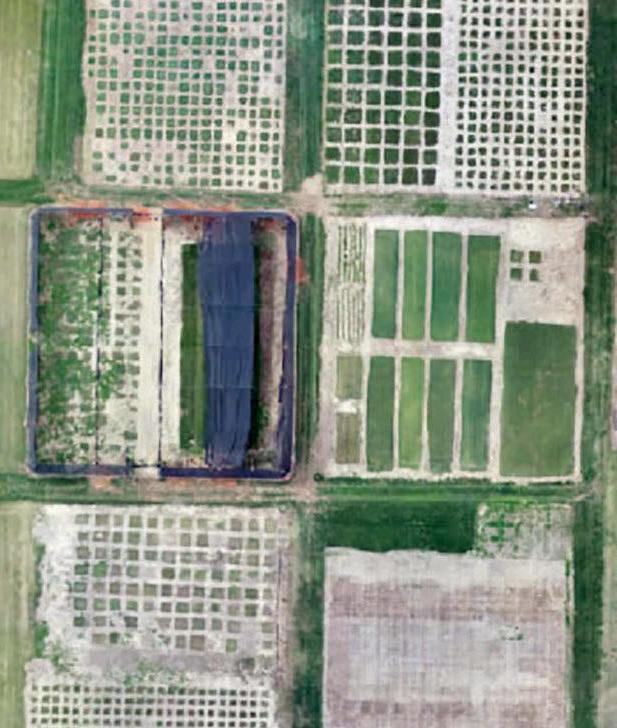
NC State turfgrass research plots as captured by a UAV (unmanned aerial vehicle, commonly known as a drone).
Jennifer Howard is communications specialist for the Crop and Soil Sciences Department of North Carolina State University. All photos courtesy of North Carolina State University.

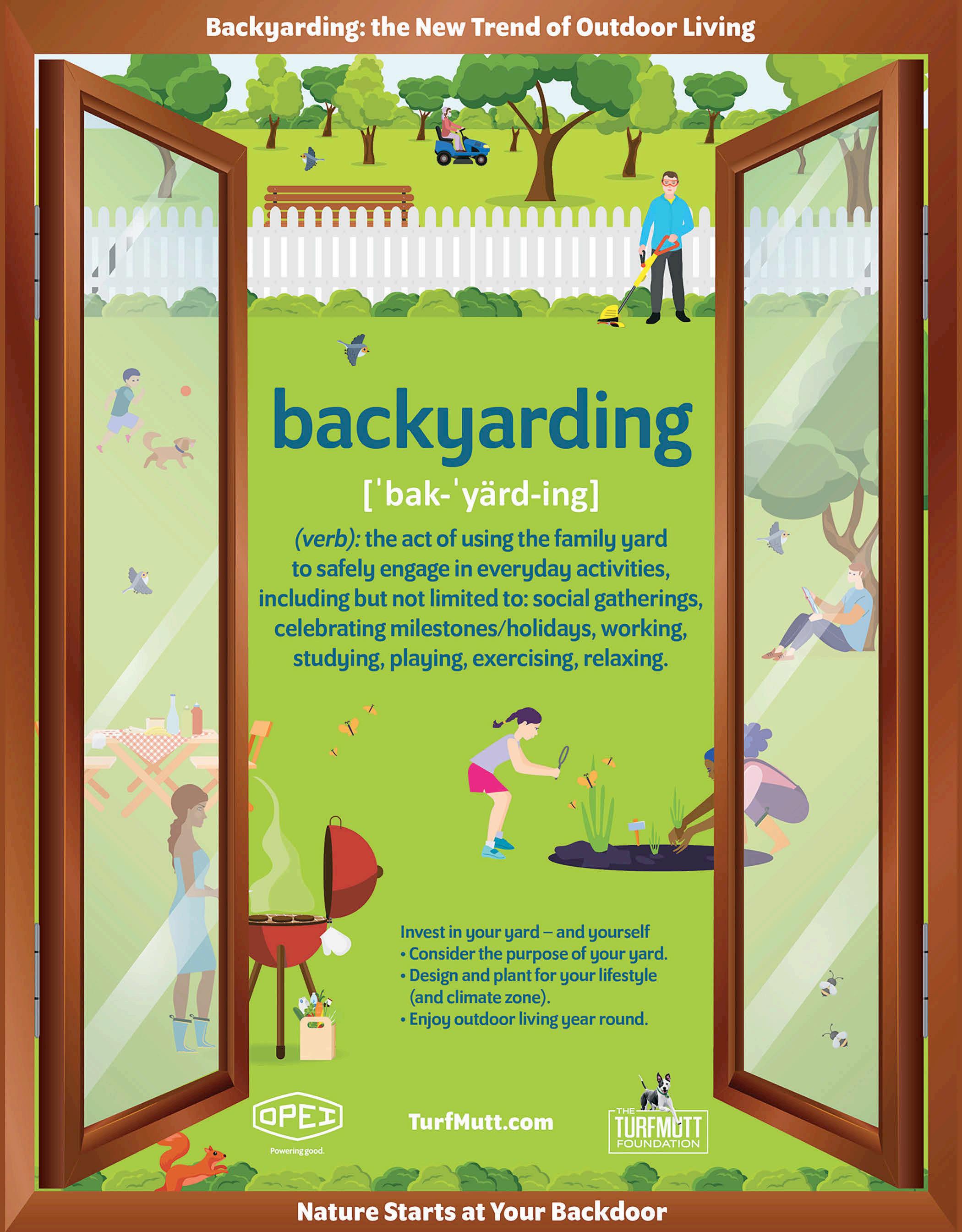
THE TURFMUTT FOUNDATION PREDICTS
Supplied by The TurfMutt Foundation
“Backyarding,” the new trend to move many indoor activities—from working in an office or classroom to dining and recreation—to the great outdoors, is growing. Under pandemic conditions, yards and other managed landscapes became safe havens for social gatherings, celebrating milestones/holidays, working, studying, playing, exercising, relaxing.
“Your own backyard is nearly limitless with possibilities, and homeowners got really creative as they expanded and enjoyed their yards over the last year,” said Kris Kiser, President and CEO of the Outdoor Power Equipment Institute (OPEI) and the TurfMutt Foundation. “We predict, long after the Covid-19 pandemic passes, our yards will become an even greater part of our lives. The notion of ‘backyarding’ is here to stay.”
In 2020, home improvements—many of them in the backyard—skyrocketed. So did the demand for natural grass sod and outdoor power equipment as homeowners invested in making their outdoor spaces fabulous, functional, and flourishing. Overall, shipments of outdoor power equipment increased 16 percent in 2020.
“Expect people to continue to invest in their outdoor life this coming spring,” said Kiser. “Many homeowners who put time and effort into their landscapes last year will be rewarded when that yard comes back to life this spring.” Be ready to help them continue or start their projects. “In 2020, home improvements—many of them in the backyard—skyrocketed. So did the demand for natural grass sod and outdoor power equipment as homeowners invested in making their outdoor spaces fabulous, functional, and flourishing.”
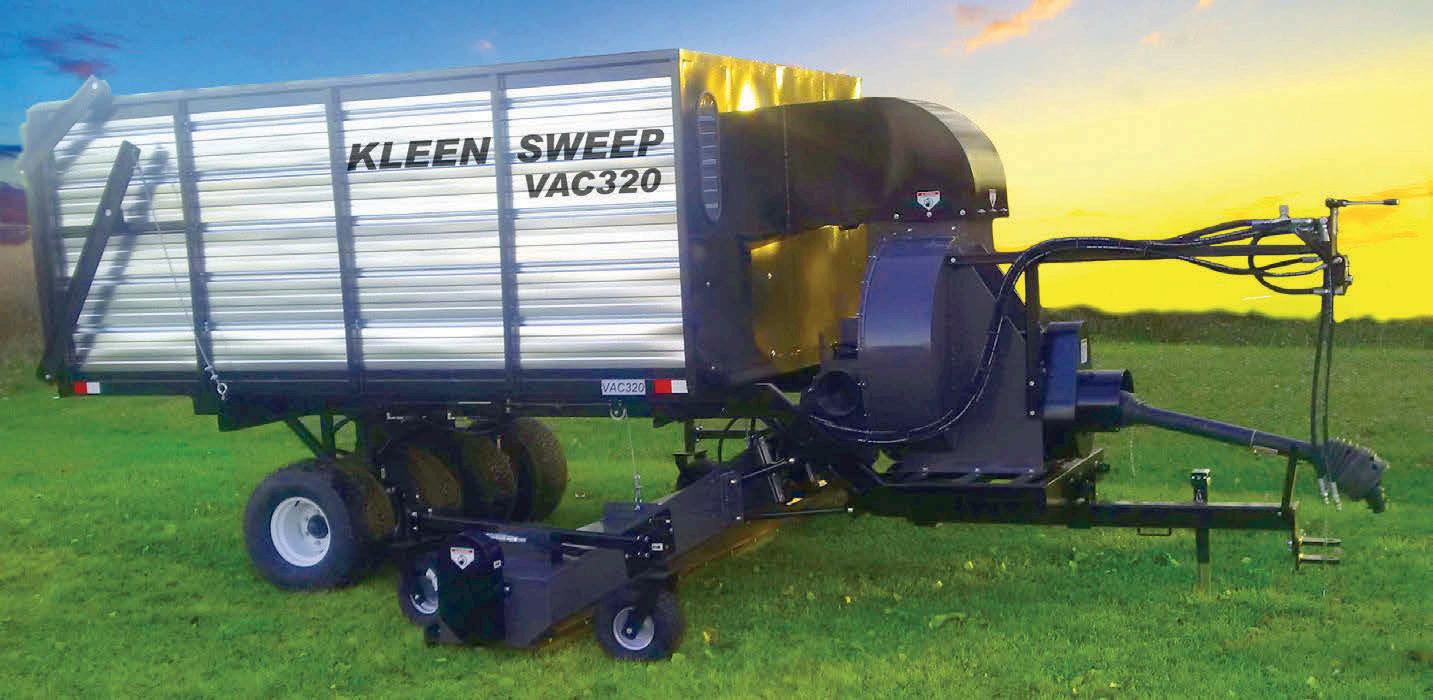

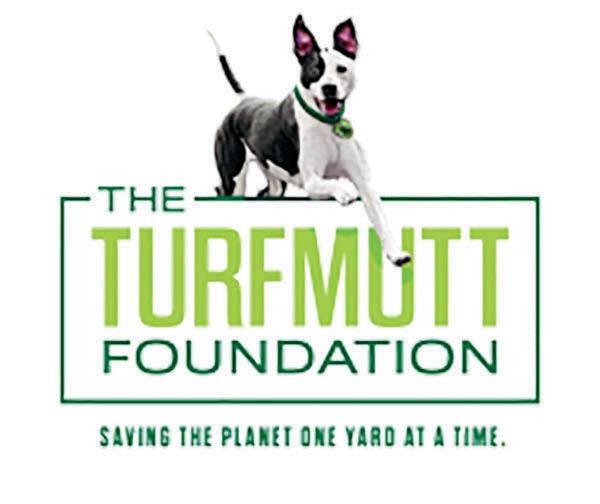
ADVANCED EQUIPMENT SALES VAC-320 Sweeper Vac VAC-320 Sweeper Vac
for your toughest clean-up jobs for your toughest clean-up jobs
See It In Action On
Kleen Sweep Vac
• 13.3 Cubic Yard Capacity • New 8 Blade Impeller Fan • 4 Turf Wheels, Floating Axles Now with 40% increase in suction as seen at TPI Field Day! • Available with 10 or 12 ft. Pick-Up • Now with 4 wheels on Pick-Up Deck for Better Floatation
Ask about the 10 Yard Vac with 7 ft. Pick-Up Head
Phone: 519-527-2929 Fax: 519-527-2150 P.O. Box 818, 21 Birch St., Seaforth, ON N0K 1W0 Website: www.advancedequipmentsales.ca
Here are some questions and suggestions to help homeowners bring more “backyarding” into their life:
1. Invest in the yard.
Design a dream lawn and garden. Consider its purpose. Don’t design just for aesthetics. Do you have kids and pets who need a place to play? Will you be hosting safe gatherings? Do you need a place for rest and relaxation and/or games and recreation?
2. Get the whole family involved.
Create a game or a friendly competition with your family to help identify all the ways you can move your indoor life to the great outdoors—and right out your backdoor. Can you take office calls and video meetings to the patio or porch? Can your kids do their online learning outdoors? How often can you take dining outside? Keeping safety in mind, can you gather outdoors for family celebrations, birthdays, graduations, and reunions?
3. Plant something—as early as possible. (Or plant more!)
Adding trees, bushes, grass, and flowering plants is a good yard investment, but they often take time to grow. Plant as early as recommended so you can enjoy the benefits faster. Just remember “right plant, right place.” Location, maintenance, sunlight, and watering needs should all be considered, as well as your climate zone.
4. Stretch winter-weary muscles.
Take workouts, yoga classes, and meditation sessions outdoors. You also can let off some steam by mowing the grass, trimming the hedges, or edging the lawn. Working in the yard not only helps our living landscapes look better and stay healthy, it also gives us a sense of accomplishment and control in trying times.
5. Plan a staycation.
A makeshift “resort” or vacation spot could be just out your back door. Pitch a tent, build a campfire, hang a sheet between trees to make a movie screen, set up games—these are just a few ideas to make the backyard a vacation spot.
6. “Level up” nature care.
Add flowering plants, trees, and shrubs to give wildlife and pollinators food and shelter. Your yard is part of the larger ecosystem, so check your climate zone for landscaping options that support your birds, bees, butterflies, and other wildlife. Don’t forget to take time to just sit and drink it in, observing the wildlife and nature around you.
Research shows simply spending time in nature—which starts in your backyard—is good for reducing stress, boosting heart health, boosting Vitamin D levels, and enhancing memory. Thanks to the family yard, the health and well-being benefits of being outside are just a few steps away.
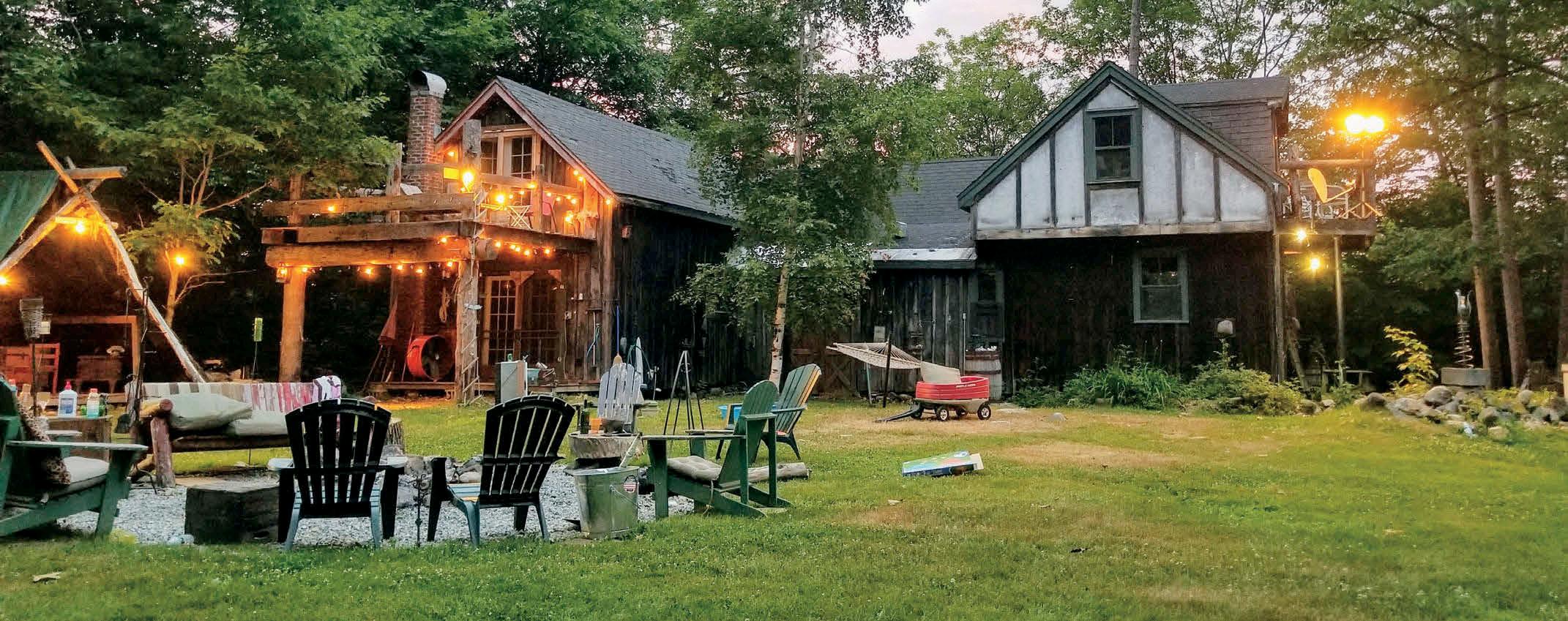
TurfMutt was created by the Outdoor Power Equipment Institute’s (OPEI) TurfMutt Foundation and has reached more than 70 million children, educators, and families since 2009. Through classroom materials developed with Scholastic, TurfMutt teaches students and teachers how to “save the planet, one yard at a time.” For more information on TurfMutt, visit TurfMutt.com. Sign up for Mutt Mail, a monthly e-newsletter with backyarding tips and all the news from the TurfMutt Foundation, at the link that follows. https://opei.us17. list-manage.com/subscribe?u=d7cbaa310f76e5b6408a28c4a&id=ef4209e160






